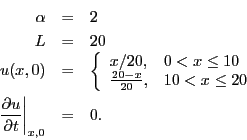Exercises:
- Determine the solution to the wave equation where
Extra credit: make a movie of the solution. - Determine the solution to the wave equation where
Extra credit: make a movie of the solution. - Compute the Fourier series for
- Compute the Fourier series for
- Determine the solution to
- Solve the heat equation with homogeneous boundary conditions with alpha=1, L=4 and a uniform initial temperature of u=1. Plot the solution for various times to illustrate the nature of the solution.
- Solve the heat equation with homogeneous boundary conditions with alpha=2, L=2 and an initial temperature distribution that is triangular, zero at both ends and with a peak of u=2 in the center. Plot the solution for various times to illustrate the nature of the solution.
- Consider the differential equation
- Show that
- Write a computer program to determine an approximate solution using the 4th order R-K method to this first order differential equation. Write your program so that it saves 1000 data points to a file, i.e., don't save every single step. Write the program so that if you change either the time step size or the total time for the simulation, it computes how to save 1000 points. In other words, don't hard code into your program some logic that only works for a specific step size and specific final time.
- Submit a plot of the approximate solution and the exact solution for this equation for the time interval from t=-1 to t=1. Use trial and error to determine an appropriate step size by comparing your approximate numerical solution to the exact solution for different step sizes and ensure that the magnitude of the maximum error is less than 0.001. Hint the step size has to be pretty small! Be sure to submit your code as well.
- Use the Matlab ode45() function to solve the equation. Submit your code and a plot of the solution and the exact solution. Does Matlab give the correct answer?
- (5 points extra credit) Figure out how to tweak the tolerances in ode45(). Is it possible to get an accurate solution?
- Write a matlab script to implement Euler's method to determine an approximate numerical solution to the above equation. An example script using Euler's method to solve the equation
If you did this method for the equation in this problem, approximately how long it would take for the script to run to return an approximate solution that is as accurate as your code from above?
Code: Select all
>> x(1) = -6; >> dt = 0.01; >> t = 0:dt:10; >> for i=2:length(t) x(i)=x(i-1)+sin(t(i-1))*dt; end >> plot(t,x)











